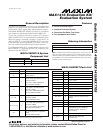
The Setup, Clock, Offset, and Gain tab sheets provide
read/ write access to each of the registers. See
Figures 2–5.
The Comms and Data (Figure 6) tab sheet provides
access to the Standby bit. The comms registers RS2,
RS1, RS0, and R/W bits are automatically set by each
register’s read and write buttons. The channel select
bits CH1 and CH0 are determined by which channel is
selected on the Measurement tab sheet.
Sampling
To collect data, go to the Measurement tab sheet and
click Sample. Select the sample size and click Begin
Sampling. After the samples have been collected, the
data is automatically uploaded to the host and is
graphed. Once displayed, the data can be saved to a
file (optional).
Saving Graphs to Disk
Data in the real-time graph and in the sampled data
graphs can be saved to a file (Figures 7–8). Only the
raw output codes are saved, but voltages can be
inferred based on the reference voltage and the maxi-
mum code value.
Evaluating Power-Down Mode
To enter standby mode, first make sure that Auto Read
is not checked in the Measurement tab sheet. Then go
to the Comms and Data tab sheet and check power-
down, then click write.
Reference Voltage
The evaluation software assumes a 2.500V reference
voltage, unless otherwise specified. To override this
value, go to the Measurement tab sheet and type the
new reference voltage next to REF voltage.
Software Listing
The EV kit software disk contains the driver source and
header file. Refer to DRV1416.cpp and DRV1416.h.
Detailed Description
of Hardware
The MAX1416 (U1) is a multichannel, 16-bit, sigma-
delta data-acquisition system. Resistors R1–R4 and
C1–C4 act as anti-aliasing filters. The MAX873 (U2) is a
2.5V reference. C14 ensures the MAX873’s stability for
arbitrary values of input capacitor C11. Level transla-
tors U3 and U4 allow the kit to support the 3V
MAX1415, as well as the 5V MAX1416. The input signal
can be applied directly to terminal blocks TB2 and TB3.
C5 and C6 bypass the analog-to-digital converter’s
power supply. See Figure 9, and refer to the MAX1416
data sheet.
Evaluating the MAX1415
To evaluate the MAX1415, request a free sample of the
MAX1415EUE and replace U1. Follow the Quick Start
procedure, with the following exceptions:
• In step 1, leave JU1 and JU2 open.
• In step 3, apply a +3VDC power supply (instead of
+5V) to TB1. Apply an external +1.225VDC differen-
tial reference between TB3 pins 3 and 2.
• After step 10, go to the software’s Measurement tab
sheet and type the new reference voltage of 1.225
next to REF voltage.
Evaluating the MX7705
To evaluate the MX7705, request a free sample of the
MX7705EUE and replace U1. The MX7705 is similar to
the MAX1415/1416 except it does not support internal
clock mode (INT must always be zero).
Using an External Reference
To use an external reference, remove the shunts from
JU1 and JU2, and connect a differential reference
between TB3 pins 3 and 2. The evaluation software
assumes a 2.500V reference voltage, unless otherwise
specified. To override this value, go to the Measurement
tab sheet and type the new reference voltage next to
REF voltage.
Troubleshooting
Problem: No output measurement. System seems to
report zero voltage, or fails to make a measurement.
Check VDD supply voltage at TB1. The EV kit requires
a separate supply in addition to the supply on the
microcontroller module. Check the reference voltage
using a digital voltmeter. Use an oscilloscope to verify
that the CS, SCLK, and DIN waveforms are correct. If
the DRDY signal is pulsing, then the software has suc-
cessfully initialized the MAX1416 and conversions have
been triggered.
Problem: Cannot see MCLK waveform on oscillo-
scope.
When using an external crystal, the MCLKIN and
MCLKOUT nodes are very sensitive to extra load
capacitance. Connecting a typical 10x scope probe
effectively doubles the load capacitance from 20pF to
40pF, which can slow down or even halt oscillation.
When using the internal oscillator (clock register INT =
1 and CLKDIS = 0), the oscillator signal is visible on the
MCLKOUT pin. In this mode, MCLKOUT can be mea-
sured using a typical 10x scope probe.
Evaluates: MAX1416/MAX1415/MX7705
MAX1416 Evaluation Kit/
Evaluation System
_______________________________________________________________________________________ 3
















